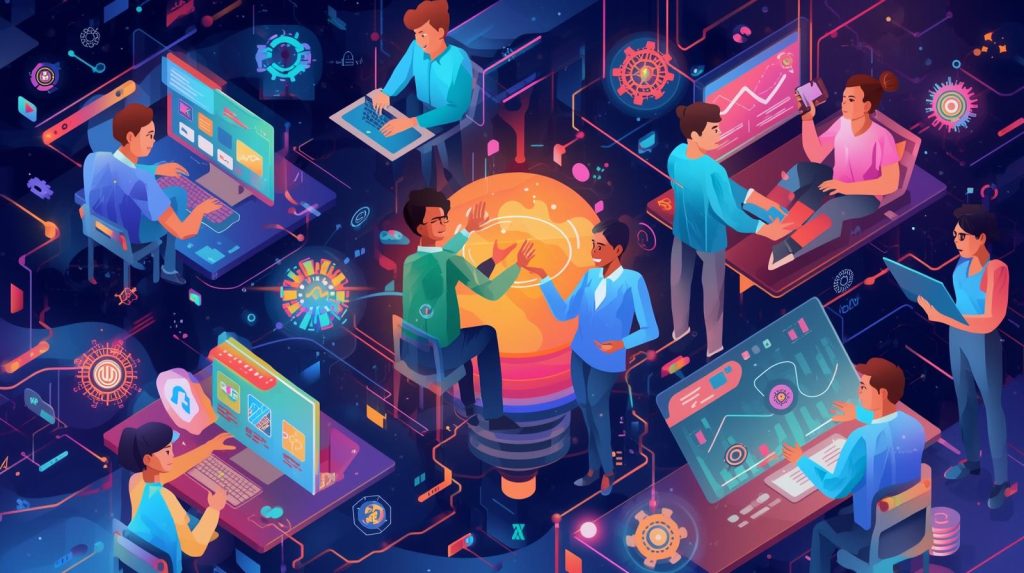
No-Code AI Revolution: Everyone’s an AI Developer Now
Introduction
By 2025, 65% of new applications are expected to be built by citizen developers — individuals with little to no coding experience who are empowered by no-code and low-code platforms. This remarkable shift is being called the No-Code AI Revolution.
Traditionally, artificial intelligence (AI) development required programming skills, advanced knowledge of data science, and access to expensive infrastructure. But today, thanks to no-code AI platforms, the barriers to entry are disappearing.
This movement is democratizing AI development. Everyday innovators, teachers, entrepreneurs, marketers, and small business owners — once excluded from the AI landscape — are now actively building AI-driven solutions. In this article, we’ll explore how the no-code AI revolution is reshaping industries, innovation, and the future of technology.
What is No-Code AI?
No-code AI refers to tools and platforms that let users create AI-powered applications without writing code. Instead of programming algorithms, users rely on drag-and-drop interfaces, pre-trained models, and visual workflows to build solutions quickly.
Traditional AI vs. No-Code AI
- Traditional AI Development: Requires coding knowledge (Python, R, TensorFlow), complex data pipelines, and deep expertise in AI/ML.
- No-Code AI Development: Uses visual workflows, templates, and automation to make AI accessible to non-technical users.
Popular No-Code AI Platforms
- Google AutoML – Simplifies machine learning with automated training.
- Microsoft Power Apps + AI Builder – Adds AI capabilities to business workflows.
- Bubble – Enables web app creation with AI integrations.
- Peltarion – Specializes in deep learning without code.
With these tools, even non-coders can become AI creators, unlocking faster and more inclusive innovation.
Why the No-Code AI Revolution Matters
The no-code AI movement isn’t just hype — it’s a fundamental shift in how technology is built and used.
1. Accessibility for All
Anyone can now create AI-powered tools, whether it’s a teacher designing a predictive learning app or a small business owner setting up a chatbot.
2. Faster Prototyping and Deployment
No-code AI drastically reduces time-to-market, helping businesses test ideas and deploy solutions in days, not months.
3. Cost Reduction
Building AI no longer requires massive budgets. Startups and SMEs can now compete with larger enterprises using affordable no-code solutions.
4. Democratization of AI
No-code AI is leveling the playing field. Instead of being limited to big tech firms, AI development without coding empowers innovators worldwide.
Citizen Developers: The Future of AI Builders
Citizen developers are professionals outside traditional IT roles — marketers, educators, healthcare workers, analysts — who leverage no-code tools to build AI solutions tailored to their needs.
- By 2025, 65% of applications will be built by citizen developers, proving that the future of AI belongs to non-technical creators.
- Citizen developers are transforming industries:
- Healthcare: Predictive analytics for better patient outcomes.
- Education: AI tutors and adaptive learning apps.
- E-commerce: Personalized recommendations and chatbots.
- Marketing: Automated customer insights and campaign optimization.
- Healthcare: Predictive analytics for better patient outcomes.
The No-Code AI Revolution is turning everyday professionals into innovators, reshaping industries from the ground up.
Key Use Cases of No-Code AI
No-code AI is already solving real-world problems. Common applications include:
- Customer Support Chatbots – 24/7 support without large teams.
- Predictive Analytics – Sales forecasting and market insights.
- Image Recognition – From quality control in factories to security systems.
- Workflow Automation – Automating repetitive tasks and saving time.
- Personal Productivity Tools – Smart assistants, scheduling bots, and AI-powered content tools.
These AI applications without coding are boosting efficiency, engagement, and growth for businesses of all sizes.
Challenges & Limitations of No-Code AI
While powerful, no-code AI does have limitations:
- Limited Customization – Pre-built templates may not handle complex needs.
- Data Privacy & Security – Sensitive data requires careful handling.
- Dependence on Pre-Built Models – May restrict flexibility and creativity.
- Need for AI Literacy – Users must still understand basic AI concepts to use tools responsibly.
No-code AI is transformative but not a replacement for technical expertise in advanced cases.
The Future of No-Code AI Development
Looking forward, the future of AI development will combine the strengths of both citizen developers and expert engineers.
- AI Will Be as Common as Spreadsheets: Just like Excel changed business operations, no-code AI will become an everyday business tool.
- Widespread Innovation Across Industries: From small startups to Fortune 500s, AI democratization will drive breakthroughs.
- Collaboration Between Non-Coders and Experts: No-code developers will handle general use cases, while professionals tackle complex AI systems.
- Preparing for the No-Code Future: Companies should start upskilling employees in AI literacy and experimenting with no-code tools now.
The No-Code AI Revolution isn’t slowing down — it’s only accelerating.
Conclusion
The No-Code AI Revolution is giving everyone the power to create AI-driven solutions, no coding required. By 2025, with most new applications expected to come from citizen developers, AI will no longer be exclusive to tech experts.
Instead, innovation will be fueled by everyday problem-solvers who harness no-code tools to build, scale, and transform industries.
The future isn’t just AI-powered — it’s AI-built by everyone.
🔗 Dive deeper into the world of AI: Here & Now AI Blog
Stay connected with us on HERE AND NOW AI & on:

